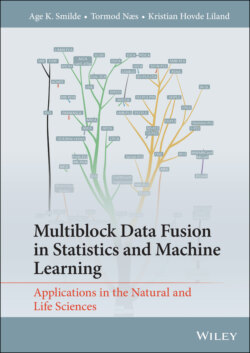Читать книгу Multiblock Data Fusion in Statistics and Machine Learning - Tormod Næs - Страница 12
List of Tables
ОглавлениеTable 1.1 Overview of methods. Legend: U = unsupervised, S = supervised, C = complex, HOM = homogeneous data, HET = heterogeneous data, SEQ = sequential, SIM = simultaneous, MOD = model-based, ALG = algorithm-based, C = common, CD = common/distinct, CLD = common/local/distinct, LS = least squares, ML = maximum likelihood, ED =eigendecomposition, MC = maximising correlations/covariances. For abbreviations of the methods, see Section 1.11
Table 1.2 Abbreviations of the different methods.
Table 2.1 Formal treatment of types of data scales. The first column refersto the scale-type. The second column gives examples of suchscale-types. The third column defines the scale-type in termsof permissible transformations (see text). Finally, the fourthcolumn gives the permissible statistics for the types of scales.
Table 2.2 Different methods for fusing two data blocks, indicating the properties in terms of explained variation within and between the blocks. Thelast two columns refer to whether the methods favour explaining within- or between-block variation. For more explanation, see text.
Table 2.3 The matrices of which the weights w are eigenvectorsin its original form and using the SVDs of X and Y.
Table 4.1 Overview of the data sets used in the genomics example.
Table 5.1 Overview of methods. Legend: U=unsupervised,S=supervised, C=complex, HOM=homogeneous data,HET=heterogeneous data, SEQ=sequential, SIM=simultaneous, MOD=model-based, ALG= algorithm-based, C=common,CD=common/distinct, CLD=common/local/distinct, LS=least squares, ML=maximum likelihood, ED=eigendecomposition,MC=maximising correlations/covariances. Forabbreviations of the methods, see Section 1.11.
Table 5.2 Different types of SCA, where Dm is a diagonal matrixand Φ is a positive definite matrix (see Section 2.8). The correlations and variances pertain to the block-scores (see text).
Table 5.3 Proportions of explained variance per component (C1, C2,…)and total in each of the blocks for the two different methods. Legend: conc is the abbreviation of concatenated; yellow is distinct for TIV; red is distinct for LAIV; green is common (see text).
Table 5.4 Properties of methods for common and distinctcomponents. The matrix D indicates a diagonalmatrix with all positive elements on its diagonal.
Table 6.1 Overview of methods. Legend: U=unsupervised,S=supervised, C=complex, HOM=homogeneous data,HET=heterogeneous data, SEQ=sequential, SIM=simultaneous, MOD=model-based, ALG= algorithm-based, C=common,CD=common/distinct, CLD=common/local/distinct, LS=least squares, ML=maximum likelihood, ED=eigendecomposition, MC=maximising correlations/covariances. Forabbreviations of the methods, see Section 1.11.
Table 7.1 Overview of methods. Legend: U=unsupervised,S=supervised, C=complex, HOM=homogeneous data,HET=heterogeneous data, SEQ=sequential, SIM=simultaneous, MOD=model-based, ALG= algorithm-based, C=common,CD=common/distinct, CLD=common/local/distinct, LS=least squares, ML=maximum likelihood, ED=eigendecomposition, MC=maximising correlations/covariances. Forabbreviations of the methods, see Section 1.11.
Table 8.1 Overview of methods. Legend: U=unsupervised, S=supervised, C=complex, HOM=homogeneous data, HET=heterogeneousdata, SEQ=sequential, SIM=simultaneous, MOD=model-based,ALG= algorithm-based, C=common, CD=common/distinct,CLD=common/local/distinct, LS=least squares, ML=maximum likelihood, ED=eigendecomposition, MC=maximising correla-tions/covariances. The green colour indicates that this methodis discussed extensively in this chapter. The abbreviations forthe methods represent the different sections and follow thesame order. For abbreviations of the methods, see Section 1.11.
Table 8.2 Tabulation of consumer characteristics. A selection of two consumer attributes/characteristics, gender, and lunch habitsis given. The numbers represent percentages in each of the categories for each of the segments (subgroups). The sumsin each column for each consumer characteristic variable isequal to 100. The lunch variable reflects the frequency of usewith 1 representing the highest frequency and 5 ‘no answer’.Source: (Helgesen et al., 1997). Repro-duced with permission from Elsevier.
Table 8.3 Consumer liking of cheese. Design of the conjointexperiment based on six design factors. Source: (Almli et al., 2011). Reproduced with permission from Elsevier.
Table 9.1 Overview of methods. Legend: U=unsupervised,S=supervised, C=complex, HOM=homogeneous data,HET=heterogeneous data, SEQ=sequential, SIM=simultaneous, MOD=model-based, ALG= algorithm-based, C=common, CD=common/distinct, CLD=common/local/distinct, LS=least squares, ML=maximum likelihood, ED=eigendecomposition, MC=maximising correlations/covariances. For abbreviations of the methods, see Section 1.11.
Table 10.1 Overview of methods. Legend: U=unsupervised, S=supervised, C=complex, HOM=homogeneous data, HET=heterogeneous data, SEQ=sequential, SIM=simultaneous, MOD=model-based, ALG= algorithm-based, C=common, CD=common/distinct, CLD=common/local/distinct, LS=least squares, ML=maximum likelihood, ED=eigendecomposition, MC=maximising correlations/covariances. The abbreviations for the methods follow the same order as the sections. For abbreviations (or descriptions) of the methods, see Section 1.11.
Table 10.2 Results of the single-block regression models. PCovR isPrincipal Covariates Regression, U-PLS is unfold-PLS,MCovR is multiway covariates regression. The 3,2,3 com-ponents for MCovR refer to the components for thethree modes of Tucker3. For more explanation, see text.
Table 10.3 Results of the multiway multiblock models. MB-PLS ismultiblock PLS, MWMBCovR is multiway multiblockcovariates regression. For more explanation, see text.
Table 10.4 SO-PLS-PM results for wine data. The four columns of num-bers correspond to the explained variances for the models forthe endogenous blocks B, C, D, and E (the numbers in paren-theses represent the number of components used). Source: (Romano et al., 2019). Reproduced with permission from Wiley.
Table 11.1 R packages on CRAN having one or more multiblock methods.
Table 11.2 MATLAB toolboxes and functionshaving one or more multiblock methods.
Table 11.3 Python packages having one or more multiblock methods.
Table 11.4 Commercial software having one or more multiblock methods.
